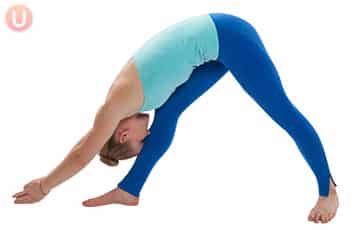How To Do Pyramid Pose
Pyramid Pose is a deep stretch for your hamstrings and low back as well as a simple way to practice balance with both feet still on the ground. Tight hamstrings and sore low backs are one of the most common reasons people seek out yoga. If this sounds like you, then you should learn how to do Pyramid Pose.
Anyone can learn how to do Pyramid Pose. It is simple enough for beginners, but can be made intense as you get better at practicing it. For instance, if you come to the pose with extremely tight hamstrings you will want to use a block or some other tool to help lessen the distance you have to reach down. It is almost like “bringing the floor closer to you”. You can even practice Pyramid Pose with a chair or bench in front of and rest your hands on the chair as you come forward. The important thing is that when you hold Pyramid Pose (or any other stretch for that matter) you are able to breath and let go of the tightness.
Another important factor in Pyramid is your alignment. You want to set your feet in line as if you are standing on a balance beam. This is how the balance element is practiced. In addition, this alignment will encourage your outer hip and low back to achieve a deeper stretch.
You can play with your arm positions in Pyramid Pose. Bringing your hands to the floor or a chair is one way. Another practice is you bring your arms around your lower back and grab hold of the opposite elbow with each hand . There are many variations once you learn the basic leg position of Pyramid Pose.
Here are the steps to learn Pyramid Pose:
1) From a standing position, step the inside of your left foot directly behind your right foot about 6-8 inches, as if you are standing on a balance beam. Back foot is angled.
2) As you inhale reach both arms high overhead, lengthening your spine.
3) As you exhale slowly reach hands down to shin or, if you are able, the floor. You can slightly bend the front knee if needed.
4) Let your chest rest over your front leg and relax the back of your neck. Breath slowly as you stretch your hamstring.
5) Hold 30 seconds and switch sides.
